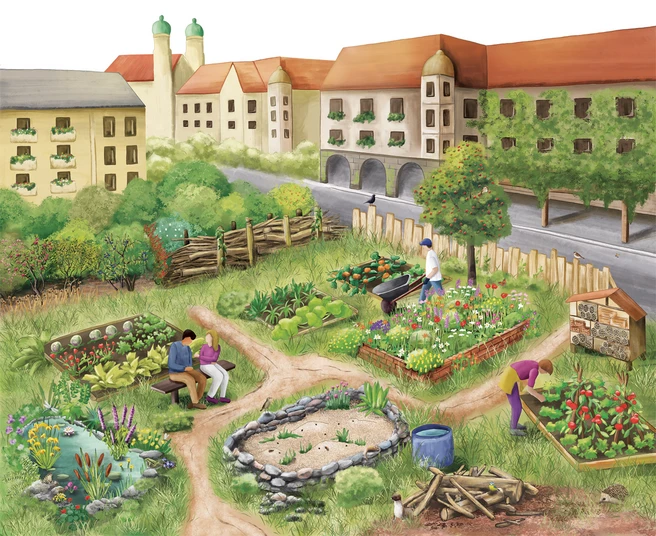The purpose of the catalog is to support gardeners, city dwellers, and dedicated initiatives in implementing targeted measures to increase biodiversity in urban areas. Whether for private gardens, community gardens, or public green spaces, the measures presented offer practical and scientifically sound recommendations that promote biodiversity and contribute to the ecological enhancement of urban habitats.
The publication is now available in German as a printed edition and as a free e-book from TUM.University Press (https://mediatum.ub.tum.de/1781539). The book is illustrated with numerous photos and illustrations and contains many sources and recommendations for further reading.
Gardeners shape biological diversity in the city
“Gardens are places where we can encounter nature directly—and actively help shape it,” says the BioDivHubs project team. "Gardeners play a central role in maintaining urban ecosystems and preserving urban biodiversity. Our goal is to support this potential with practical and easily implementable measures. This catalog is a call to take action and to take the first steps, to be creative, to make mistakes, to learn together, and to exchange experiences in order to shape our urban ecosystems to support biodiversity."
The catalog of measures is aimed at anyone who wants to promote biodiversity in their environment — regardless of prior knowledge or how much space they have to work with. The recommendations range from selecting insect-friendly plants and creating flowering areas, diverse hedges, green facades, deadwood structures, or sand and stone structures to building nesting aids and designing and implementing near-natural ponds. Existing knowledge about the impact on biodiversity was taken into account when developing the measures. They are based on the results of ecological research in community gardens led by the TUM since 2020 and the scientific literature. These research results were combined with the many years of practical experience of gardeners from community gardens as well as praxis partners in the BioDivHubs project.
Successful collaboration between science and praxis-initiatives
The catalog is the result of the “BioDivHubs – Biodiversity in the Neighborhood” project, which brings together gardening enthusiasts, neighborhoods, scientists, and civil society organizations to jointly develop solutions for greater biodiversity in urban nature. The partners in this project, which is funded by the Federal Agency for Nature Conservation, are the BürgerStiftung München, Green City e.V., the Münchner Umwelt-Zentrum e.V. at the ÖBZ in cooperation with Ackermannbogen e.V., the Technical University of Munich (TUM), and the Museum für Naturkunde Berlin.
Prof. Monika Egerer on the cooperation between scientific urban garden research and the Munich project partners: “With this combination of TUM research results and practical experience, we want to provide guidelines for measures to protect biodiversity in small to large formats that translate our research into practice and the real world.”
Fall and winter tip: The natural garden in autumn – piles of leaves
A tip for ecological gardening this winter is to leave piles of leaves as winter habitat for wild animals from David Schoo, researcher at the TUM School of Life Sciences at BioDivHubs: Autumn storms let the leaves and dead branches fall from the trees. On the streets and in many gardens, they are swept up and disposed of as trash in the bin. But they are actually valuable organic material. Not only can they be used as mulch for vegetable beds, but they can also be piled up into leaf and brush piles, creating a habitat for numerous insects and other wildlife.
Here you will find soil organisms such as springtails and earthworms, which break down the leaves into valuable humus improving the soil fertility. These animals also provide hedgehogs, shrews, and toads with the energy-rich food they need to get through the winter. Leaves store heat and moisture, creating a stable microclimate and thus an ideal place to hibernate. Unlike compost, leaf piles are not turned over and therefore provide a safe place where numerous wild animals can hibernate undisturbed.
Garden tip: Choose a quiet corner of the garden, preferably in partial shade. Loosely layer various clippings, leaves, and branches on top of each other. The more structure, the better. Once created, the pile is left to its own devices and develops into a permanent refuge for many species.
Further valuable tips on how to make gardens and public green spaces more species-rich can be found in the BioDivHubs catalog “Gardening for more biodiversity in the city.”
About the BioDivHubs project
“Biodiversity in the neighborhood – gardeners and residents working together with civil society organizations, scientists, and other urban stakeholders to promote greater biological diversity in urban nature.” (BioDivHubs for short) is a transdisciplinary project funded by the Federal Agency for Nature Conservation (BfN) as part of the Federal Biological Diversity Program with funds from the Federal Ministry for the Environment, Climate Protection, Nature Conservation, and Nuclear Safety (BMUKN).
More information: www.biodivhubs.net
Press contact to the project team BioDivHubs: info@biodivhubs.net
